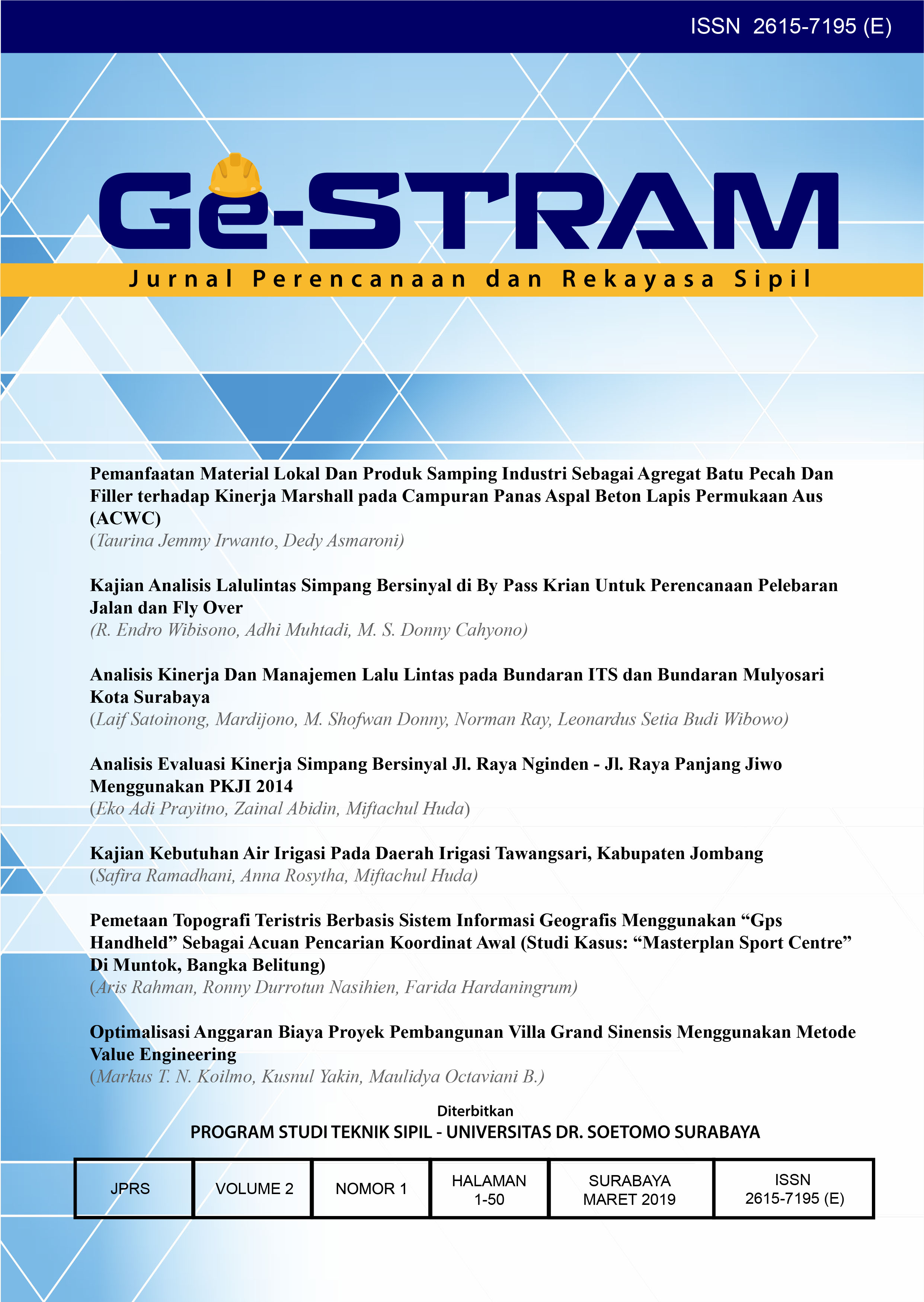Pemanfaatan Material Lokal Dan Produk Samping Industri Sebagai Agregat Batu Pecah Dan Filler terrhadap Kinerja Marshall pada Campuran Panas Aspal Beton Lapis Permukaan Aus (ACWC)
 Abstract views: 642
,
Abstract views: 642
,
 PDF downloads: 573
PDF downloads: 573
Abstract
The use of ACWC asphalt as a surface layer in Madura continues to increase as traffic growth increases following the opening of the Suramadu Bridge. In addition to having the advantages of stability in accepting loads compared to other types of surface layers, ACWC asphalt is also easily made and carried out in the field. However, asphalt mixing plant (AMP) companies in Madura still use materials from outside Madura as coarse aggregates such as river breaking stones and fly ash and cement used as fillers to improve stability. Based on this, this research was carried out by utilizing local meter which has the same properties in the form of local Madura crushed stone which will be used as coarse aggregate and industrial by-products in the form of rice husk ash (by-product of brick industry) and limestone powder (limestone mining byproducts ) used as filler. For this purpose samples were made with the percentage of filler used was 2%, 4%, 6%, 8% and 10%. Marshall test testing includes calculation of density, flow, VMA, VIM, VFB, and stability. From the test results, AC-WC uses local materials with both types of filler, namely Limestone and Rice Husk Ash. There is one type of mixture that meets the Marshall characteristics, namely the use of local materials and filler of limestone 8% asphalt variation 6.5%. With a value of 2,285 Density, 1,852,863 kg Stability, Flow 3,467 mm, Marshall Quotient 534,48 kg / mm, VIM 3,058%, V.M.A 15,941%, VFB 80,819%. While the local material and fillers of Rice Husk Ash from the results of Marshall Test for Flow, VIM, and VFB did not meet the requirements so that the use of rice husk ash filler could not be used as a substitute for cement.
References
Achmad Fadli, (2010) “Tinjauan sifat – sifat agregat untuk campuran aspal panas (Studi kasus beberapa quary di Gorontaloâ€, Jurnal Saintek , Vol 5,
Asphalt Institute. 2001. Construction of Hot Mix Asphalt Pavement. Manual Series 22.2nd. USA.
Anonim.,1991, “Metode Pengujian Campuran Laston dengan Alat Marshallâ€, Yayasan Badan penerbit Pekerjaaan Umum, Jakarta.

Asphalt Institute. 1993. The Asphalt Handbook, Manual Series No.2 (MS- 2), The Asphalt Institute.
Ali, H (2010). “ Karakteristik campuran asphalt concrete-wearing course (AC-WC) dengan penggunaan abu vulkanik dan abu bata sebagai filler†Jurnal Rekayasa Vol. 15 No. 1, April 2011.
Departemen Permukiman dan Prasarana Wilayah Dirjen Prasarana Wilayah, 2002, “Manual perkerasan campuran beraspal panas Buku 1: Petunjuk umum “
Departemen Pekerjaan Umum Direktorat Jenderal Bina Marga,2010, “Spesifikasi umum†Kementrian Pekerjaan Umum, Jakarta
Fanisa, H dan Wahyudi, M (2010).“ Perencanaan campuran aspal beton dengan menggunakan filler kapur padamâ€. Program Studi Diploma III Teknik Sipil Fakultas Teknik Universitas Diponegoro, Semarang.
Fauzi, A (2013). “Pengaruh penggunaan batu pecah madura dan batu pecah jawa terhadap kuat tekan beton†Jurusan Teknik Sipil Fakultas Teknik Universitas Madura, Pamekasan.
http://kelanakota.suarasurabaya.net/news/2016/168000-Mulai-2-Maret-Tarif-Tol-Suramadu-Turun-50-Persen. (06 Juni 2017).
Korompis Steward Paulus,Kaseke Oscar H,Diantje Sompie (2015), “Kajian Laboratorium Penggunaan Material Agrgegat yang Bersumber dari Kaki Gunung Soputan untuk Campuran Beraspal Panasâ€, Jurnal Sipil Statik Vol 3, Manado
Kementrian Pekerjaan Umum. 2010. “Spesifikasi Umum Bina Marga Revisi3â€.Yayasan Penerbit Pekerjaan Umum, Jakarta.
Qodar, T (2016). “Pengaruh penggunaan serbuk batu kapur putih madura sebagai filler pada campuran aspal panas (hotmix) asphalt concrete wearing course (acwc) terhadap karakteristik marshallâ€. Jurusan Teknik Sipil Fakultas Teknik Universitas Madura, Pamekasan.
Sukirman, Silvia (1999), Perkerasan Lentur Jalan Raya, Nova, Bandung,
Sukirman, Silvia (2003), Beton Aspal Campuran Panas, Granit, Jakarta
Sugiyono (2006).“Statistika Untuk Penelitian Pendidikan Pendekatan Kuantitatif, Kualitatif dan R&Dâ€. Bandung: Alfabeta.
Yulianto, FE dan Mukti, MH (2015).“Penggunaan abu sekam padi sebagai bahan aditif pada beton campuran 1Pc:2Ps:3Kr untuk meningkatkan kuat tekannyaâ€. Universitas Madura, Pamekasan.
Copyright (c) 2019 Dedy Asmaroni, Taurina Jemmy Irwanto

This work is licensed under a Creative Commons Attribution-ShareAlike 4.0 International License.
Authors who publish with this journal agree to the following terms:
- Authors retain copyright and grant the journal right of first publication with the work simultaneously licensed under a Creative Commons Attribution-ShareAlike 4.0 International License that allows others to share the work with an acknowledgement of the work's authorship and initial publication in this journal.
- Authors are able to enter into separate, additional contractual arrangements for the non-exclusive distribution of the journal's published version of the work (e.g., post it to an institutional repository or publish it in a book), with an acknowledgement of its initial publication in this journal.
- Authors are permitted and encouraged to post their work online (e.g., in institutional repositories or on their website) prior to and during the submission process, as it can lead to productive exchanges, as well as earlier and greater citation of published work (See The Effect of Open Access).

This work is licensed under a Creative Commons Attribution-ShareAlike 4.0 International License.















